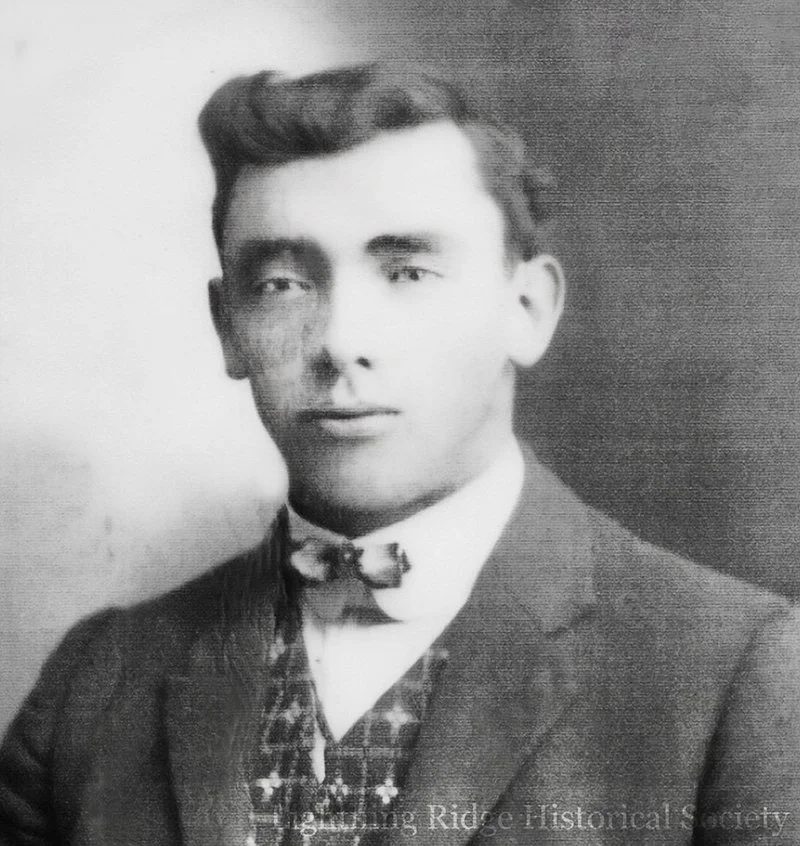Fred Bodel
Frederick 'Fred' Bodel was born 13 June 1881 at Collector (near Goulburn), New South Wales.
Fred was a shearer and an opal miner, as was often the case with early miners at Lightning Ridge. Fred was in Lightning Ridge from around 1907 onwards.
He camped at the New Chum between shearing seasons and relocated to the Three Mile in the 1930s living in a two-room hut built by German brothers, where he died in 1973.
By the 1960s, Fred was the self-proclaimed Mayor of Three Mile Flat, the area formerly known as the Nettleton settlement.
Transcript: I was here cutting scrub in the big drought. That was the biggest drought ever known in Australia. (When was that?) 1902. (Ah yeah, big drought.) That's what we called the big drought, all low lands. (1902.) Culminated 1902, it was on for seven years. (Oh.) 1895 to 1902 before it broke. (And what were you cutting scrub for? For feed or what?) Sheep! (And they eat the scrub, do they?) Well, certainly they would. Eat it too quick. (What sort of scrub do they eat?) All this edible scrub. (It's all edible.) leopardwood, rosewood, wilgas, belahs, whatever sort. There's 25 different sorts.
Fred with the Governor General, 1967.
In 1967, Fred welcomed the Governor General to his camp. Lord Casey and his wife Maie Casey were in town for the unofficial opening of the bowling club. The track to Fred's hut even got graded for the revered guests and was graded again in 2008 when acting Governor General Marie Bashir came to open the Australian Opal Centre’s showroom in Morilla Street.
A very young, and handsome Fred Bodel, dressed up in his Sunday best. Likely around 1907.
Fred was a lucky miner and had several big opal strikes. Fred was also involved in the discovery of the Pandora stone, found by Jack McNicol in 1928.
Fred never married or had any children, he was engaged once but got wind of his fiancé and brother Bill being photographed at the 1907 Sydney Royal Show. Fred spoke to neither of them ever again!
Fred Bodel’s camp is one of the oldest remaining miner’s dwellings on the opal fields, it sits in a gully on the Three Mile Flat, in the location of the old Nettleton settlement.
Transcript: (And when you came here did you give up station work?) No, I didn't, you couldn't live here you couldn't make a living on opal then. (Couldn't you?) No! You get about, well, you get…what, an eight-quart billy can-full. You'd sell for 75 quid. Beautiful big stones what they're getting 2,000 pound piece for today. (Oh.) Nobody wanted it. (Many men on the field in those days?) Oh, no, many. Oh, about a dozen I’d say, twenty. (Oh, just a little group.) Only just started it was. (I see.) There never was a great many on, this was the biggest rush of all, this Three Mile. (Was it?) I suppose there were about 1,500 here when the Three Mile broke out in 1908. In 1909, it was booming, and ‘10. That's when the Three Mile here was booming. But they had surveyed the town, where it is today before that. The town was there on the flat. That road round, that's the main street. (I see.) There was eight stores along there. (Oh, and they shifted it?) Yeah, made them shift up to the town. They wouldn't give them a licence, a business licence.
“Trevor Ives presented the Society with a shoebox containing a statue of an old-timer, modelled in clay, complete with wooden walking stick - who could this man be?
‘Unmistakeably Fred Bodel’, we all agreed! You can imagine Trevor’s relief that we recognized Fred. He registered his own surprise to see that we actually were in possession of the walking stick! ”
Fred Bodel passed away on 25 October 1973 and is buried at Lightning Ridge Cemetery.
Fred Bodel’s signature, sourced from the 1929 petition for a public park at Lightning Ridge.
Article: Research by Leisa Carney, edited by Russell Gawthorpe. LRHS research compiled by Len Cram and Barbara Moritz. Sources: The Lightning Ridge Book, Stuart Lloyd, 1967, pp. 37-38, 56, 109; Lightning Ridge - The Home of the Black Opal: Unique to the World, Gan Bruce, 1983, pp. 19, 21, 68; The Opal Book, Frank Leechman, 1961, p. 203; An Old Chum Remembers, The Story of Lightning Ridge 1906-1921, John M. Landers, 1923 (2002), p. 24. Wendy Lowenstein Australian Folklore and Social History Collection, 1971, National Library of Australia, item 51987180.







